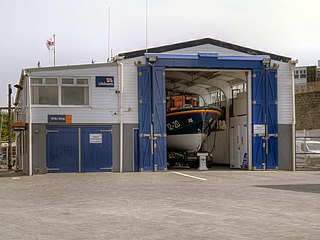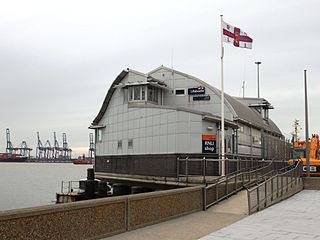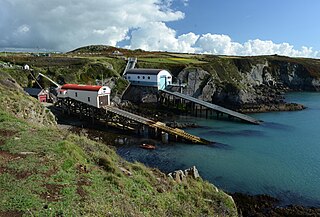
Walmer Lifeboat Station was established in 1830. Over two thousand ships are believed to have been wrecked on the Goodwin Sands, and the masts of several wrecks are visible from the shore at low tide. Hence there have always been two lifeboats located at the joined towns of Deal and Walmer along the coast opposite the sands.

Great Yarmouth and Gorleston lifeboat station is a RNLI base in Norfolk, England. There were originally two separate stations at Great Yarmouth and Gorleston – two coastal towns either side of the River Yare. These were merged in 1926.

Ramsgate Lifeboat Station is a Royal National Lifeboat Institution (RNLI) station located in the Port of Ramsgate in the English county of Kent. The station is one of the oldest to operate in the British Isles and has launched to many notable services. Among the awards won by its crews over the years are 42 RNLI medals, including 2 gold, 39 silver and 1 bronze, the last being awarded in 2000.

The Mumbles Lifeboat Station opened in 1835 with a lifeboat that was funded and managed by Swansea Harbour Trustees and was known as Swansea Lifeboat Station. The station was taken over by the RNLI in 1863 and moved to Mumbles in 1866. The station only officially became The Mumbles Lifeboat Station in 1904.

The Southend-on-Sea lifeboat station is a lifeboat station at Southend-on-Sea in the English county of Essex, operated by the Royal National Lifeboat Institution (RNLI) since 1879.

Torbay Lifeboat Station is the base for Royal National Lifeboat Institution (RNLI) search and rescue operations at Brixham, Devon in England. Brixham Lifeboat Station was opened in 1866 but since 1924 has been known as 'Torbay'. Since 2005 it has operated a Severn-class all-weather lifeboat (ALB) together with a D-class (IB1) inshore lifeboat (ILB).

The Valentia Lifeboat Station is a Royal National Lifeboat Institution station located at Knightstown, Valentia Island, County Kerry, Ireland.

Southwold Lifeboat Station is an RNLI operated lifeboat station located in the town of Southwold in the English county of Suffolk.

Lowestoft Lifeboat Station is a Royal National Lifeboat Institution (RNLI) operated lifeboat station in the town of Lowestoft in the English county of Suffolk. The station is located at the mouth of Lowestoft's outer harbour on the South pier. It is one of the oldest lifeboat stations in the United Kingdom, having been established in 1801.

Margate Lifeboat Station is a Royal National Lifeboat Institution (RNLI) station located in Margate in the English county of Kent. The station is over 160 years old. Its crews have earned a number of gallantry awards, including five silver and 1 bronze RNLI medals for bravery.

Dover Lifeboat Station is a Royal National Lifeboat Institution (RNLI) lifeboat station located in the town of Dover in the English county of Kent. The station first opened in 1837, coming under the RNLI’s control in 1855.

Harwich Lifeboat Station is a Royal National Lifeboat Institution (RNLI) station located in the town of Harwich in the English county of Essex. The station is positioned on the southern side at the mouth of the River Orwell estuary. The station serves a particularly busy section of coastline with Harwich being a very busy ferry terminal. Across the estuary is the Port of Felixstowe which is the United Kingdom's busiest container port.

Yarmouth Lifeboat station is an RNLI station located in the town of Yarmouth on the Isle of Wight in the United Kingdom. The station has been based in Yarmouth's harbour since 1924. Previously the station had been in Totland Bay, west of Yarmouth, until it was decided that the station need a motor lifeboat. The current Severn-class lifeboat is moored afloat and shore facilities are on the quayside in Yarmouth. The station covers the western Solent with its all-weather lifeboat 17-25 Eric and Susan Hiscock (Wanderer) (ON-1249) which has been on service at Yarmouth since 2001.

Shoreham Harbour Lifeboat Station is a Royal National Lifeboat Institution (RNLI) station located in the town of Shoreham-by-Sea in the English county of West Sussex. It underwent extensive re-development in 2010 with a new purpose built boathall to accommodate its new Tamar-class all-weather lifeboat (AWB). It operates two lifeboats, the Tamar-class Enid Collett and the D-class (IB1) Inshore lifeboat Joan Woodland (D-784).

St Davids Lifeboat Station is a Royal National Lifeboat Institution (RNLI) station. It was opened in 1869 and to date has been involved in saving over 360 lives at sea in more than 420 launches. The station operates both an all-weather (ALB) and an inshore (ILB) lifeboat.

Moelfre Lifeboat Station is located in the village of Moelfre, Anglesey. A lifeboat was first stationed here in 1848 by the Anglesey Association for the Preservation of Life from Shipwreck.

Humber Lifeboat Station is an All-weather lifeboat station based at the mouth of the River Humber.

Scarborough Lifeboat Station is a Royal National Lifeboat Institution (RNLI) operated lifeboat station in Scarborough, North Yorkshire, England. A lifeboat was established at Scarborough in 1801, which makes it the third oldest lifeboat station in the United Kingdom.

Whitby Lifeboat Station is a Royal National Lifeboat Institution (RNLI) lifeboat station located in Whitby, North Yorkshire, England. It is one of nine situated along the Yorkshire coast. Whitby has had a lifeboat station since 1802, with the RNLI responsible since 1861. In its 200 plus year history, Whitby has had five different lifeboat stations. A sixth lifeboat and station was located at Upgang, just up the coast from Whitby, and whilst it was considered separate from Whitby, it was crewed by men from the Whitby lifeboat.

Clacton-on-Sea Lifeboat Station is a Royal National Lifeboat Institution (RNLI) station located in the town of Clacton-on-Sea in the county of Essex. A lifeboat was first stationed here by the RNLI in 1878.























